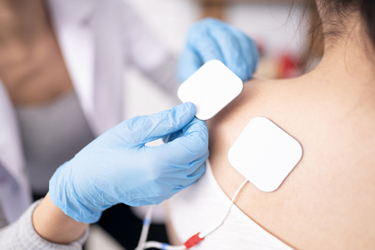Wearable Electro-Patches: 4 Development Considerations
By Yael Hanein, Ph.D., CTO and founder, X-trodes

When developing wearable sensor patches capable of providing medical-grade monitoring outside of clinical settings, we must begin by appreciating that creating a fully functional system involves some essential building blocks, all of which must work together. From the technological perspective, developing the patch may appear to be the first step. However, being able to design a working patch in a way that is compliant with specific guidelines and will be accepted by regulatory authorities must be learned and applied.
Developing a multimodal solution for at-home use entails significant effort and expertise. Central to this is understanding the problem you are trying to solve, especially when developing electrode patches intended for a diverse range of applications, from sleep monitoring and analysis to sports rehabilitation. The level of knowledge and expertise required for each application can be immense. Sleep alone is a huge field, with over 40 different sleep-related disorders, each of which must be fully understood. This entails understanding the medical manifestation of the particular disorder, the different technologies involved, and how existing technology is already being applied. This is before we even begin to address the various commercial issues and market needs.
1. A Multimodal Solution Requires A Multifaceted Team
Central to an endeavor focused on developing a multimodal wearable solution is building a multifaceted team comprising all the necessary expertise prior to initiating development. Such a team cannot be siloed, as there are many key areas where team members must fully understand the intricacies of different domains. For example, in the initial stages of designing electrode patches, those responsible for developing the electronic components must also have a deep understanding of the fundamental issues relating to the different interfaces the patches will interact with — in our case, primarily the skin and neural interfaces. Similarly, data scientists working on the algorithms must also appreciate the limitations of the hardware, as well as the market requirements and specific medical domain being addressed.
It is therefore incumbent on team leaders to draw on talented, multidisciplinary professionals when developing a new solution. Encouraging dexterous team members able to immerse themselves in the various domains related to wearable technology will prove a key element in successfully introducing a medical-grade wearable technology to market.
2. Collaboration With Industry Players Is Key
Developing a medical-grade wearable solution cannot occur in a vacuum, especially when it comes to the relatively small ecosystem involved in the application of flexible electronics for electrophysiological monitoring. From the outset, it is essential to tap into the wider industry for insights, collaborating with other players, such as leading researchers and sleep centers, who can provide essential feedback based on their own experiences.
This approach can entail certain frustrations, especially in the earliest R&D stages, which can result in initial angles being rejected outright by a traditionally risk averse industry. However, such feedback will ultimately prove invaluable, not just in determining which direction to take but also understanding the factors that may cause a solution to be rejected; in many instances, this will come down to cost or lengthy production times. Thus, sourcing knowledge from the wider industry can encourage further creativity and, through perseverance and continually trialing different concepts and approaches, result in the ability to develop a solution that fully addresses the needs of the market.
3. Ensure Ease Of Use
Addressing usability and simple self-application is central to developing an at-home solution, ensuring that the final product does not require intensive training while also providing clinical-grade results. This boils down to the design — how the device is physically designed and how much room for error can be allowed when operating it. This must be addressed from the earliest stages of development, taking into account the users — be they physicians or patients — and working out all the various user interface issues. The way in which a company designs a medical wearable technology will directly correlate to the frequency of errors. Therefore, tackling design interface issues at the earliest stages will pave the way for developing a reliable and robust device suitable for medical applications.
One particular challenge arises when developing a method to affix the electro-patches to the body in a way that ensures highly accurate readings, in different environments and for extended periods of time, without impacting users’ comfort. Paramount to developing a viable wearable solution is ensuring that the system has a small form factor. In the context of wearable electrodes, developers must ensure that the patch attaches to the skin seamlessly and is transparent so that users can perform naturally without having their lives impacted by the system. This will naturally relate to the weight and dimensions of the electronic system. In the case of X-trodes, this required collaborating with leading companies in the fields of printing and adhesives. Tapping into their expertise enabled the development of a dry-printed electro-patch that is easily self-administered by patients, does not require any gel or adhesive, and is flexible enough to comfortably conform to the natural contours of the body, enabling continuous monitoring in any environment.
4. Ensure Efficacy Of Data
The ultimate goal when developing a wearable monitoring solution is to provide the user, be they end users or medical practitioners, with actionable insights. However, this may not necessarily be the data that the system provides directly. For example, while cardiac measurements can be provided by an ECG trace, a trained professional is still needed to analyze the data and provide a medical evaluation. In many aspects of medical practice, data is provided in a very crude form. However, the end goal is to have analyzed data that can provide actionable insights and medical advice. Achieving this in a stable manner requires a significant effort, made even more challenging when we try to shift to fully automated data analysis.
Overcoming this challenge requires a large amount of data preparation and signal processing routines, which must be adapted to provide data that can be analyzed and the bottom line provided automatically. Medical data is generally collected under relatively sterile conditions in controlled environments. An at-home solution must be able to provide that same quality of medical-grade data collected in real-life scenarios, outside of clinical settings. This requires removing as many external interferences as possible. When the end user is moving and performing natural activities, ensure that daily — or even high-impact — activity does not interfere with the system’s recording and processing capabilities. Thus, a properly designed system must address the dual challenge of ensuring that the device does not interfere with the user’s natural behavior while, at the same time, a person’s normal behavior does not impact the quality of data collection. This will ensure that, from the beginning, the data collected is as clean as possible, as data contaminated with lots of external artifacts will make the analysis extremely challenging.
Thus, a significant effort has to be put into developing algorithms, either by optimizing existing algorithms or developing entirely new ones, that can identify a variety of different conditions and allow the automation of processes that enable us to understand the data received — whether clean or contaminated — which can then be analyzed. A number of new approaches, such as neural network models and deep learning, are proving invaluable in their ability to make automated decisions without requiring a person to physically analyze and evaluate the data.
Conclusion
Designing and developing a medical-grade wearable solution, therefore, entails multiple interlocking components to ensure market acceptance and adoption by clinicians and end users. Ultimately, it boils down to the ability to provide insightful and actionable data through a user-friendly device in diverse environments. Wearable monitoring devices generate vast amounts of data essential for establishing the medical validity of the solution. Any glitch in the system can result in a loss of data, without which we cannot establish medical validity. Therefore, the ability to generate clean and validated data via a robust and usable system is integral in order to progress from proof of concept to development and eventual commercialization.
About The Author:
 Yael Hanein, Ph.D., is CTO and founder of X-trodes, a company bringing medical-grade electrophysiological monitoring to the comfort of users’ homes. Currently a professor of electrical engineering at Tel Aviv University, she has previously conducted research at the Weizmann Institute and the University of Washington. Focusing on neuro-engineering and developing wearable electronics and bionic vision, she has co-authored over 90 peer-reviewed papers and is recognized as one of the world’s leading researchers in the field of neural interfaces. She was listed among the 50 most influential women in Israel by Lady Globes in 2012, included in The Marker’s 2013 list of the most innovative people in Israel in 2013, and ranked in the Forbes Israel Power Women list for 2019.
Yael Hanein, Ph.D., is CTO and founder of X-trodes, a company bringing medical-grade electrophysiological monitoring to the comfort of users’ homes. Currently a professor of electrical engineering at Tel Aviv University, she has previously conducted research at the Weizmann Institute and the University of Washington. Focusing on neuro-engineering and developing wearable electronics and bionic vision, she has co-authored over 90 peer-reviewed papers and is recognized as one of the world’s leading researchers in the field of neural interfaces. She was listed among the 50 most influential women in Israel by Lady Globes in 2012, included in The Marker’s 2013 list of the most innovative people in Israel in 2013, and ranked in the Forbes Israel Power Women list for 2019.
